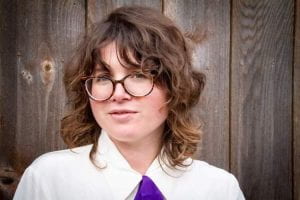We thank these Winter and Spring Graduate Employees for your service and say goodbye to Program Coordinator, Tim Herrera, who moved on to a teaching position at UO’s Department of Anthropology, and Fullbright Fellow, Iryna Stavynska (Ukraine), who spent a full year supporting OFN. Interested in joining the team? Contact us for short-term opportunities, or watch for the Program Coordinator position opening in late summer!
 Jessica Oravetz is a first-year M.A. student in Folklore and Public Culture. She earned her B.A. in History and German with a minor in Honors Interdisciplinary Studies from Western Washington University. She was deeply inspired by her mentors and professors at WWU to pursue teaching and interdisciplinary, humanities-focused studies at the graduate level. Her primary interests lie in asking what it means to live well. She hopes to explore the emotional experience as a part of the human experience, and how people have turned to folklore in order to navigate those waters. Her other interests include dipping chocolate truffles, fostering kittens for the local humane society, and playing the harp.
Jessica Oravetz is a first-year M.A. student in Folklore and Public Culture. She earned her B.A. in History and German with a minor in Honors Interdisciplinary Studies from Western Washington University. She was deeply inspired by her mentors and professors at WWU to pursue teaching and interdisciplinary, humanities-focused studies at the graduate level. Her primary interests lie in asking what it means to live well. She hopes to explore the emotional experience as a part of the human experience, and how people have turned to folklore in order to navigate those waters. Her other interests include dipping chocolate truffles, fostering kittens for the local humane society, and playing the harp.
Oravetz assisted OFN with coordinating its Culture Fest program, which connects Oregon arts institutions with OFN’s Culture Keepers Roster to lead events.
 Elise O’Brien is a graduate student in Folklore Studies and Landscape Architecture at University of Oregon. She lives, works and plays in rural Lane County. Her research is interdisciplinary and flows from the confluence of culture and design. Elise enjoys crossing the rural/urban divide, works with art supply access for the unhoused (might art supplies be considered a basic need?), leads guided meditations to envision design potentialities, and endlessly ponders utopian imaginaries. She asks: “Are there cultural solutions for design issues?” Are there spatial solutions for cultural problems?” Elise is on the local planning committee for American Folklore Society in Portland Nov 1-4, 2023 and also works for the APRU Sustainable Cities and Landscapes Hub. Her future work will be in climate resilience, and she is presently inspired by how folk life acts as resistance to imperial and colonial projects.
Elise O’Brien is a graduate student in Folklore Studies and Landscape Architecture at University of Oregon. She lives, works and plays in rural Lane County. Her research is interdisciplinary and flows from the confluence of culture and design. Elise enjoys crossing the rural/urban divide, works with art supply access for the unhoused (might art supplies be considered a basic need?), leads guided meditations to envision design potentialities, and endlessly ponders utopian imaginaries. She asks: “Are there cultural solutions for design issues?” Are there spatial solutions for cultural problems?” Elise is on the local planning committee for American Folklore Society in Portland Nov 1-4, 2023 and also works for the APRU Sustainable Cities and Landscapes Hub. Her future work will be in climate resilience, and she is presently inspired by how folk life acts as resistance to imperial and colonial projects.
Summer staff include Yosser Saidane and CiCi Becker, plus interns Ariel Lutnesky and Cassie Hoglund.


